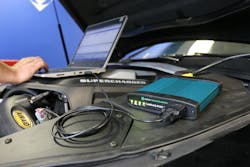Revenue opportunities with reflashing and reprogramming
Beginning with model year 2018, automakers will be required to provide all OBD-II information necessary for diagnosis and repair of vehicles. This includes the OEM software information needed to complete vehicle reflashing.
Reflashing, sometimes referred to as reprogramming, is the process of updating a vehicle’s ECU calibration software with an updated version of the software.
"The J2534 market has seen significant changes over the past (several) years," says Glen Eaton, Product Manager, J2534 Products, Drew Technologies. "With later vehicle models having more and more modules and sensors, more manufacturers are providing more ECU programming capabilities and relearn procedures than ever before. Tool manufacturers and OEs alike have made significant improvements in how the tools are made and how the software is written."
Before having access to the necessary information to complete reflashing, independent repair shops would send customers back to the dealership to have this service completed, or they might call a mobile diagnostic technician complete the service.
"Programming has been, and is now even more of, an important tool to add to the shop's toolbox," Eaton says. "What better way to increase a shops capability and service opportunities than to have their own J2534 tool? Without one, the shop is sending the vehicle elsewhere for that service, or simply turning away that business. Imagine the extra time required to send the vehicle elsewhere, perhaps involving towing as well and holding the customers vehicle for a longer period of time, which greatly affects the customers satisfaction. Add all the negative aspects together of not owning a J2534 device, then the cost of owning one becomes a no-brainer," says Eaton.
Prior to this standardization, many OEMs would use their own unique software language to communicate with a vehicle’s ECU for software updates. “This made diagnostics and reprogramming different for every manufacturer, even individual car platforms within the same manufacturer,” says John McNelis, Manager, Sales and Marketing, DG Technologies. “Tool and software developers had to communicate with all of these different formats” prior to the J2534 standard.
In 2004, SAE International J2534 Standard was introduced to “Provide the framework to allow reprogramming software applications from all vehicle manufacturers the flexibility to work with multiple vehicle data link interface tools from multiple tool suppliers,” according to the SAE International website.
Essentially, this allows the automotive aftermarket access to any emission-related programming OEM information in a standardized format.
The J2534 standard was solidified with the implementation and adoption of the Right to Repair Memorandum of Understanding (MOU).
The MOU states automakers must be voluntarily compliant (or, in the case of the state of Massachusetts, mandated) to provide access to OE level data to consumers and the automotive aftermarket. This include access to diagnostic and repair information, at the dealer level, for 2002 and newer vehicles; as well as pass-thru support beginning with 2018 model year vehicles.
However, many automakers have agreed to go above and beyond the minimum requirement from the MOU.
"While the mandate of Right to Repair is for model year 2018 (and beyond) for full module programming and diagnostic capabilities, many OEMs have provided these capabilities as far back as 1996," Eaton says.
How to complete vehicle reflashing
What’s the actual process for completing vehicle reflashing? There is some setup involved.
Users must first have the necessary equipment on hand – a Windows platform computer connected to a J2534-compliant pass-thru device, which is then connected to the vehicle through the OBD-II port – and obtain access to the OE software to aid in the reflashing.
After setup, users start the reflashing process and follow the computer prompts to complete it.
The OEM subscription information will be the variable which changes for every reflashing event, because it’s dependent on how much the OEM charges for this information.
“The user must pay to subscribe to the OEM service website to access the latest vehicle software calibration files,” says John McNelis, Manager, Sales and Marketing, DG Technologies. .
And that price tag varies substantially, depending on the vehicle manufacturer. “Many start at $24.95 per day, but some require an annual subscription ranging from $750 to $1,300 per year,” he explains.
“This separation of reprogramming and diagnostics for newer cars and older cars is a major factor in the price difference of some interface adapter tools on the market today. Distributors and shop owners should buy and sell tools that will do both. They are more expensive,” says McNelis.
About the Author
Erica Schueller
Editorial Director | Commercial Vehicle Group
Erica Schueller is the Editorial Director of the Endeavor Commercial Vehicle Group. The commercial vehicle group includes the following brands: American Trucker, Bulk Transporter, Fleet Maintenance, FleetOwner, Refrigerated Transporter, and Trailer/Body Builders brands.
An award-winning journalist, Schueller has reported and written about the vehicle maintenance and repair industry her entire career. She has received accolades for her reporting and editing in the commercial and automotive vehicle fields by the Truck Writers of North America (TWNA), the International Automotive Media Competition (IAMC), the Folio: Eddie & Ozzie Awards and the American Society of Business Publication Editors (ASBPE) Azbee Awards.
Schueller has received recognition among her publishing industry peers as a recipient of the 2014 Folio Top Women in Media Rising Stars award, acknowledging her accomplishments of digital content management and assistance with improving the print and digital products in the Vehicle Repair Group. She was also named one Women in Trucking’s 2018 Top Women in Transportation to Watch.
She is an active member of a number of industry groups, including the American Trucking Associations' (ATA) Technology & Maintenance Council (TMC), the Auto Care Association's Young Auto Care Networking Group, GenNext, and Women in Trucking.
In December 2018, Schueller graduated at the top of her class from the Waukesha County Technical College's 10-week professional truck driving program, earning her Class A commercial driver's license (CDL).
She has worked in the vehicle repair and maintenance industry since 2008.

